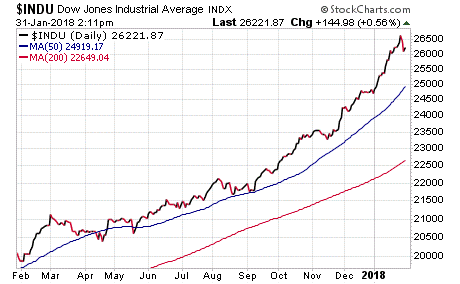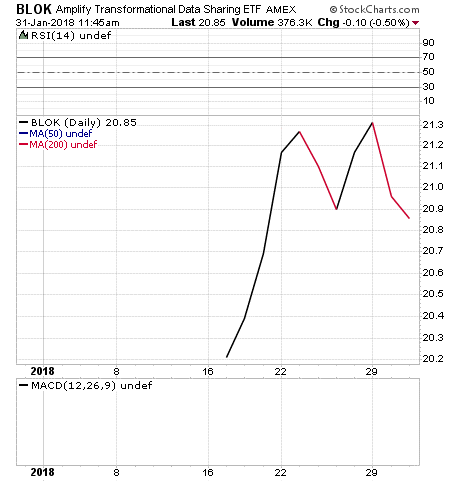The ‘S.W.A.T. Guy’ Gauge Is Screaming Volatility
I have a clear indicator that tells me when markets are feeling uneasy. I call it the “S.W.A.T. Guy” gauge, and here’s how it works.
I live on a small horse ranch in Southern California, and I have the good fortune of having some great neighbors. My closest neighbor is a retired deputy sheriff, and former S.W.A.T. team leader.
In addition to being an all-around cool guy, he’s also the kind of neighbor you want, and the kind that’s always got your back. I also try to be that same kind of neighbor, and that’s why when he asks me about the equity markets and investing, I’m always there to try and help him make sense of it.
On Tuesday, when the Dow Jones Industrial Average was down about 400 points, I got a call from S.W.A.T Guy asking me what was going on, and what to do about it.
What I told him was this market is finally starting to see something that we haven’t really seen in about two years, and that is the return of volatility.
Last week, that volatility started to rear its head, at least on an intraday basis, as we saw big intraday moves last Wednesday, and then again last Thursday. Yet despite the intraday price action in the majors, when the final bell rang in each of those respective trading sessions, stocks basically had closed unchanged.
Then last Friday, stocks rebounded sharply, but that didn’t last. On Monday of this week, the selling resumed, with the Dow closing the session down 0.67%. Of course, the real selling took place Tuesday, with Industrials down some 1.37%, or 363 points.
As of this writing, the Dow is up about 0.60% in Wednesday’s trade. And here again, we are seeing this market display some intraday volatility, as stocks opened the session much higher.
So, why are we finally seeing the return of volatility?
Well, there are a number of reasons why, including reactions to mixed, but overall good, earnings reports. Remember, we are in the heart of earnings season, and while there have been a few high-profile disappointments (Colgate-Palmolive Co. (CL), Johnson & Johnson (JNJ)) we’ve also seen some great reports from 3M (MMM), Boeing (BA), Caterpillar (CAT) and Intel (INTC).
Then there’s also the uncertainty over the pace of rising interest rates; the overbought status of markets, geopolitics, domestic politics (a.k.a. the Mueller Russia investigation), and the lack of a big upside catalyst such as tax cuts, which, of course, are already a known quantity for markets.
Yet more important than the short-term causes of volatility, what I told S.W.A.T Guy is that one must look at markets with a wider lens than just the daily price action.
For example, the Dow is on track for its 10th-consecutive monthly gain, and we should close out the month with a 5.5% Dow win. The wider S&P 500 Index also had a great month, also logging its 10th-consecutive monthly gain, up about 5%. To round out the major indices, the NASDAQ Composite is on track to close out January with a 6% monthly gain.

And, if we look at things from an even wider perspective, we see the Dow has logged a one-year gain of 32% while the S&P 500 has gained 24.1%. The NASDAQ just edged out the Dow for top honors, with a one-year gain of 32.3%.
After gains like these, the market is bound to see some profit taking from time to time. In fact, I am surprised we haven’t seen much more profit taking over the past several months.
The bottom line here is that if you are invested in this market, there is no reason to panic, and no reason to exit. The bullish tailwinds of a strong economy, strong labor market, favorable tax and regulatory environment, strong corporate earnings and not-aggressive global central banks means this market’s default setting is “higher.”
Until those tailwinds die down, neither S.W.A.T. Guy, nor you, should be too nervous.
***********************************************************
ETF Talk: This New Blockchain ETF Is Outperforming the Competition
Bitcoin may have been the biggest story of 2017, but the blockchain technology it is based on may be an even bigger force to be reckoned with in the future.
Investors who are looking to “get their foot in the door” with blockchain may want to check out Amplify Transformational Data Sharing ETF (BLOK), an actively managed fund that invests in companies around the globe which are in the blockchain space. Blockchain provides a record of new transactions, such as the change in the location of cryptocurrency, research data, or voting records.
Owning a cryptocurrency such as bitcoin gives you a “private key” of sorts into the blockchain record. BLOK is extremely new to the market, having been launched simultaneously in mid-January 2018 with another blockchain-oriented fund, BCLN. Investors promptly found both exchange-traded funds (ETFs) and poured an estimated $262 million into them in only two weeks.
Compared head to head with BCLN, BLOK is performing better so far. As of Jan. 27, BLOK rose 4.75% since its inception, compared to 3.22% for BCLN. As of Jan. 26, BLOK had more than twice BCLN’s assets under management, with $174 million compared to $87 million for BCLN. BLOK’s expense ratio sits at 0.70%.

The companies held in this fund are big names in their respective technology spaces and part of the general blockchain conversation. For example, investors who are paying attention to the blockchain craze will not be surprised to find NVIDIA (NVDA) and Overstock.com (OSTK) among BLOK’s holdings. There are not too many holdings in this fund yet, so its performance is likely to be characterized by bigger moves than many larger ETFs.
The top holdings for BLOK are Taiwan Semiconductor (TSM), 6.13%; Digital Garage (DLGEF), 5.79%; Overstock.com Inc. (OSTK), 5.46%; SBI Holdings Inc. (SBHGF), 5.43%; and NVIDIA Corp. (NVDA), 4.61%. The top 10 holdings comprise 47.4% of assets.
ETFs come in all shapes and sizes, and for those on the hunt for blockchain companies, the new Amplify Transformational Data Sharing ETF (BLOK) could be a worthwhile starting point for consideration.
As always, I am happy to answer any of your questions about ETFs, so do not hesitate to send me an email. You just may see your question answered in a future ETF Talk.
*********************************************************************
The Feds Want Your Bitcoin Profits
Bitcoin, cryptocurrencies and blockchain technologies have become all the rage over the past year.
Some people think bitcoin and other cryptocurrencies are going to liberate the planet from the clutches of fiat currencies and big-government-controlled central bank manipulation. Others think they represent the biggest bubble and the biggest boondoggle in recent market history.
I suspect that the truth lies somewhere in between. I also think the rise of non-government-controlled cryptocurrencies can be both a liberating development for society, and a giant bubble at the same time.
While the drama that is bitcoin, cryptocurrencies and the volatile nature of this asset will play itself out over time, there is one constant that never seems to go away — and that constant is Uncle Sam wanting a pound of flesh.
For example, in November, a federal court ruled in favor of the U.S. Internal Revenue Service (IRS) in its suit against cryptocurrency exchange Coinbase.
The IRS wanted to get information from Coinbase on transactions worth $20,000 or more between 2013 and 2015. Coinbase refused the IRS request, so the agency took Coinbase to court — and won.
In a recent article on the website Finance Magnates about this concern, “No Taxation Without Decentralization: The IRS Closes in on Crypto,” writer Rachel Macintosh noted:
“2017 was also the year that cryptocurrency caught the eyes of the world’s governments in a serious way. The global fever to regulate cryptocurrency has certainly not passed through the West without affecting none other than the Internal Revenue Service (IRS), the United States government’s department of taxation.”
“In addition to the exponential rise of the crypto markets at large, the IRS has certainly taken notice that a relatively low number of tax returns reporting crypto capital gains have been filed, despite the fact that so many new investors came into the space.”
The Coinbase data “request” by the IRS was part of that move to get a handle on the cryptocurrency trading profits. And as Macintosh further wrote:
“So far, there has been no direct implication that the United States government is taking steps to seize information from other centralized crypto wallets and exchanges. However, the fact that it has happened at all is certainly some indication of the future.
“One thing is clear — the IRS has a vested interest in collecting on funds gained from trading and holding cryptocurrency.”
This last point should come as no surprise to anyone, as the IRS has always wanted a piece of your trading profits. Every investor who has ever declared a capital gain knows that.
So, if you are dabbling in bitcoin or other cryptocurrencies, remember that it’s an asset class subject to taxation just like any other. And though governments don’t consider bitcoin and other cryptocurrencies “legal tender” in the official sense, if you buy and sell these assets with U.S. dollars, and if you make a profit in U.S. dollars, those dollars are going to have to be declared.
Hey, even Coinbase got into the reminder act, as it now has put the following reminder graphic on its website:

Of course, the flipside here is that given the volatility in bitcoin and related stocks, trusts and exchange-traded funds (ETFs) in 2017, many investors probably have a few realized losses that can be used to offset any gains.
Beginning last week, I’m featuring one of several new ETFs in the bitcoin-related space. Indeed, the entire subject of cryptocurrencies and the blockchain technology on which it rests has become an exciting — and now very investable — area.
ETF issuers know this, and that’s why this month there have been two new funds that have come to market in the space.
In today’s ETF Talk, you’ll find our second in the series on these funds, the Amplify Transformational Data Sharing ETF (BLOK).
I think you’ll find this series most interesting.
And remember, if you want my latest ETF, mutual fund and stock recommendations, check out my Successful Investing advisory service, or go to my website at JimWoodsInvesting.com.
*********************************************************************
Navy Yard Wisdom
“Every job is a self-portrait of the person who did it. Autograph your work with excellence.”
— Anonymous
This week’s pearl of wisdom comes to us from reader John H., who told me he had first seen the above quote at a Philadelphia Navy Yard exposition in the early 1990s. I had never seen this quote before, but I love it. Moreover, it’s how I try to live my life every moment. You see, we have but one life that we are certain of, and this is it. So, if you want to make that life excellent, then you must autograph that life with excellence. And, the best way to do that is to take extreme ownership of your work.
Wisdom about money, investing and life can be found anywhere. If you have a good quote you’d like me to share with your fellow readers, send it to me, along with any comments, questions and suggestions you have about my newsletters, seminars or anything else. Click here to ask Jim.


